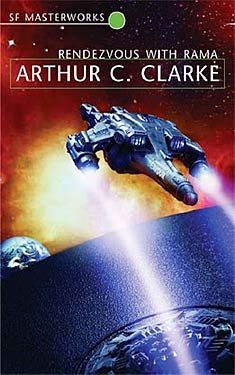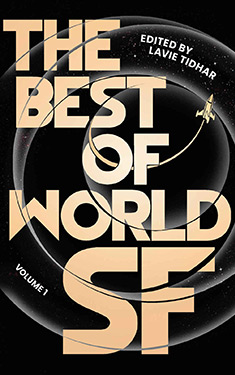
Added By: Administrator
Last Updated: valashain
Rendezvous with Rama
| Author: | Arthur C. Clarke |
| Publisher: |
Gollancz, 2006 Harcourt Brace Jovanovich, 1973 Galaxy Science Fiction, 1973 |
| Series: | Rama Series: Book 1 |
|
1. Rendezvous with Rama |
|
| Book Type: | Novel |
| Genre: | Science-Fiction |
| Sub-Genre Tags: | First Contact Hard SF Space Exploration |
| Awards: | |
| Lists: |
|
| Links: |
|
| Avg Member Rating: |
|
|
|
|
Synopsis
At first, only a few things are known about the celestial object that astronomers dub Rama. It is huge, weighing more than ten trillion tons. And it is hurtling through the solar system at inconceivable speed. Then a space probe confirms the unthinkable: Rama is no natural object. It is, incredible, an interstellar spacecraft. Space explorers and planet-bound scientists alike prepare for mankind's first encounter with alien intelligence. It will kindle their wildest dreams... and fan their darkest fears. For no one knows who the Ramans are or why they have come. And now the moment of rendezvous awaits -- just behind a Raman airlock door.
Excerpt
Spaceguard
Sooner or later, it was bound to happen. On June 30, 1908, Moscow escaped destruction by three hours and four thousand kilometers--a margin invisibly small by the Standards of the universe. On February 12, 1947, another Russian city had a still narrower escape, when the second great meteorite of the twentieth century detonated less than four hundred kilometers from Vladivostok, with an explosion rivaling that of the newly invented uranium bomb.
In those days there was nothing that men could do to protect themselves against the last random shots in the cosmic bombardment that had once scarred the face of the Moon. The meteorites of 1908 and 1947 had struck uninhabited wilderness; but by the end of the twenty-first century there was no region left on Earth that could be safely used for celestial target practice. The human race had spread from pole to pole. And so, inevitably
At 0946 GMT on the morning of September 11 in the exceptionally beautiful summer of the year 2077, most of the inhabitants of Europe saw a dazzling fireball appear in the eastern sky. Within seconds it was brighter than the Sun, and as it moved across the heavens-at first in utter silence-it left behind it a churning column of dust and smoke.
Somewhere above Austria it began to disintegrate, producing a series of concussions so violent that more than a million people had their hearing permanently damaged. They were the lucky ones.
Moving at fifty kilometers a second, a thousand tons of rock and metal impacted on the plains of northern Italy, destroying in a few flaming moments the labor of centuries. The cities of Padua and Verona were wiped from the face of the Earth; and the last glories of Venice sank forever beneath the sea as the waters of the Adriatic came thundering landward after the hammer blow from space.
Six hundred thousand people died, and the total damage was more than a trillion dollars. But the loss to art, to history, to science-to the whole human race, for the rest of time-was beyond all computation. It was as if a great war had been fought and lost in a single morning; and few could draw much pleasure from the fact that, as the dust of destruction slowly settled, for months the whole world witnessed the most splendid dawns and sunsets since Krakatoa.
After the initial shock, mankind reacted with a determination and a unity that no earlier age could have shown. Such a disaster, it was realized, might not occur again for a thousand years-but it might occur tomorrow. And the next time, the consequences could be even worse.
Very well; there would be no next time.
A hundred years earlier, a much poorer world, with far feebler resources, had squandered its wealth attempting to destroy weapons launched, suicidally, by mankind against itself. The effort had never been successful, but the skills acquired then had not been forgotten. Now they could be used for a far nobler purpose, and on an infinitely vaster stage. No meteorite large enough to cause catastrophe would ever again be allowed to breach the defenses of Earth.
So began Project Spaceguard. Fifty years later-and in a way that none of its designers could ever have anticipated - it justified its existence.
Intruder
By the year 2130, the Mars-based radars were discovering new asteroids at the rate of a dozen a day. The Spaceguard computers automatically calculated their orbits and stored the information in their own enormous memories, so that every few months any interested astronomer could have a look at the accumulated statistics. These were now quite impressive.
It had taken more than 120 years to collect the first thousand asteroids, since the discovery of Ceres, largest of these tiny worlds, on the very first day of the nineteenth century. Hundreds had been found and lost and found again; they existed in such swarms that one exasperated astronomer had christened them "vermin of the skies." He would have been appalled to know that Spaceguard was now keeping track of half a million.
Only the five giants-Ceres, Pallas, Juno, Eunomia, and Vesta-were more than two hundred kilometers in diameter; the vast majority were merely oversized boulders that would fit into a small park. Almost all moved in orbits that lay beyond Mars. Only the few that came far enough sunward to be a possible danger to Earth were the concern of Spaceguard. And not one in a thousand of these, during the entire future history of the solar system, would pass within a million kilometers of Earth.
The object first catalogued as 31/439, according to the year and the order of its discovery, was detected while it was still outside the orbit of Jupiter. There was nothing unusual about its location; many asteroids went beyond Saturn before turning once more toward their distant master, the Sun. And Thule II, most far-ranging of all, traveled so close to Uranus that it might well be a lost moon of that planet.
But a first radar contact at such a distance was unprecedented; clearly, 31/439 must be of exceptional size. From the strength of the echo, the computers deduced a diameter of at least forty kilometers. Such a giant had not been discovered for a hundred years. That it had been overlooked for so long seemed incredible.
Then the orbit was calculated, and the mystery was resolved-to be replaced by a greater one. 31/439 was not traveling on a normal asteroidal path, along an ellipse which it retraced with clockwork precision every few years. It was a lonely wanderer among the stars, making its first and last visit to the solar system-for it was moving so swiftly that the gravitational field of the Sun could never capture it. It would flash inward past the orbits of Jupiter, Mars, Earth, Venus, and Mercury, gaining speed as it did so, until it rounded the Sun and headed out once again into the unknown.
It was at this point that the computers started flashing their "We have something interesting" sign, and, for the first time, 31/439 came to the attention of human beings. There was a brief flurry of excitement at Spaceguard headquarters, and the interstellar vagabond was quickly dignified by a name instead of a mere number. Long ago, the astronomers had exhausted Greek and Roman mythology; now they were working through the Hindu pantheon. And so 31/439 was christened Rama.
For a few days, the news media made a fuss over the visitor, but they were badly handicapped by the sparsity of information. Only two facts were known about Rama: its unusual orbit and its approximate size. Even this last was merely an educated guess, based upon the strength of the radar echo. Through the telescope, Rama still appeared as a faint, fifteenth-magnitude star-much too small to show a visible disc. But as it plunged in toward the heart of the solar system, it would grow brighter and larger month by month; before it vanished forever, the orbiting observatories would be able to gather more precise information about its shape and size. There was plenty of time, and perhaps during the next few years some spaceship on its ordinary business might be routed close enough to get good photographs. An actual rendezvous was most unlikely; the energy cost would be far too great to permit physical contact with an object cutting across the orbits of the planets at more than a hundred thousand kilometers an hour.
So the world soon forgot about Rama. But the astronomers did not. Their excitement grew with the passing months as the new asteroid presented them with more and more puzzles.
First of all, there was the problem of Rama's light curve. It didn't have one.
All known asteroids, without exception, showed a slow variation in their brilliance, waxing and waning in a period of a few hours. It had been recognized for more than two centuries that this was an inevitable result of their spin and their irregular shape. As they toppled end over end along their orbits, the reflecting surfaces they presented to the sun were continually changing, and their brightness varied accordingly.
Rama showed no such changes. Either it was not spinning at all or it was perfectly symmetrical. Both explanations seemed unlikely.
There the matter rested for several months, because none of the big orbiting telescopes could be spared from their regular job of peering into the remote depths of the universe. Space astronomy was an expensive hobby, and time on a large instrument could easily cost a thousand dollars a minute. Dr. William Stenton would never have been able to grab the Farside two-hundred-meter reflector for a full quarter of an hour if a more important program had not been temporarily derailed by the failure of a fifty-cent capacitor. One astronomer's bad luck was his good fortune
Stenton did not know what he had caught until the next day, when he was able to get computer time to process his results. Even when they were finally flashed on his display screen, it took him several minutes to understand what they meant
The sunlight reflected from Rama was not, after all, absolutely constant in its intensity. There was a very small variation-hard to detect, but quite unmistakable, and extremely regular. Like all the other asteroids, Raina was indeed spinning. But whereas the normal "day" for an asteroid was several hours, Rama's was only four minutes.
Stenton did some quick calculations, and found it hard to believe the results. At its equator, this tiny world must be spinning at more than a thousand kilometers an hour. It would be rather unhealthy to attempt a landing anywhere except at the poles, because the centrifugal force at the equator would be powerful enough to flick any loose objects away from it at an acceleration of almost one gravity. ltama was a roiling stone that could never have gathered any cosmic moss. It was surprising that such a body had managed to hold itself together, and had not long ago shattered into a million fragments.
An object forty kilometers across...
Copyright © 1973 by Arthur C. Clarke
Reviews
Images




















 Full Details
Full Details






